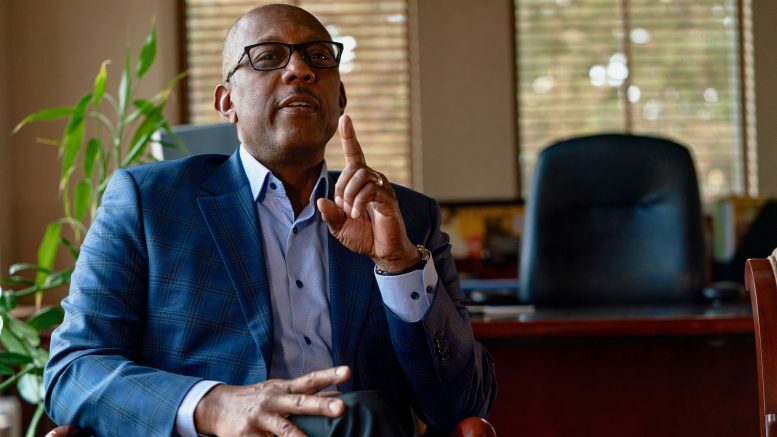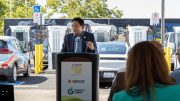SN&R: Can you give me an overview of the Sierra Health Foundation?
Hewitt: The purpose of the Sierra Health Foundation is to promote health and wellness in all the communities it serves, which at its origin was around 26 counties in Northern California. We also now work in the eight counties to the south of Sacramento, the San Joaquin Valley.
Our approach to health isn’t just about access to clinical care; it’s also about the places (people) live, work and play, and all the social forces and economic forces that contribute to, or degrade, the health of communities.
SN&R: Why did the Sierra Health Foundation, along with the James Irvine Foundation, establish the $15 million Community Economic Mobilization Initiative?
Hewitt: Over the past 10 years or so, we have focused heavily on the social determinants of health—where you live, access to support, etc.—but we also believe that the economic conditions in those communities contribute to, or reduce, the likelihood of folks having great health.
If you map … poor communities, they have higher rates of illness, particularly chronic diseases. Folks live shorter lives, have higher rates of mortality, and that is part-and-parcel to the experience of living in poor communities across America.
This is an effort to try to improve the economic conditions under which people live by giving them opportunities and access to the investments that we know are being made at the federal level and state level, as we try to rebuild the economy post-pandemic and (one) that’s more climate-resilient.
Let’s make sure that those communities that are often left out have the opportunity to fully participate in all the new or expanding industries, and the expansive job opportunities that this big idea represents.
SN&R: California will receive $139 billion in combined federal investment and state surplus. What kind of programs do you have in mind that can accomplish the goals you just talked about: helping marginalized communities and making them more climate-resilient?
Hewitt: We know that one of the illnesses that you see disproportionately in poor communities is asthma. We know asthma is impacted heavily by air quality. We know that air quality in poor communities tends to be worse because of the kind of industries that are located in poor neighborhoods and by the housing conditions in poor neighborhoods. Those environmental conditions impact rates of asthma and the prevalence of hospitalizations for those who have asthma. We know that those communities would be helped if you had fewer fossil-fuel-burning cars in those neighborhoods because that would improve the air quality.
So when we talk about the Community Economic Mobilization Initiative and the extraordinary level of investments that are going to take place across the country, which have requirements to focus on communities that are often left behind, then we know that if you’re going to build car-charging stations, they need to be in South Sacramento and not just North Sacramento. If you’re going to train people to service car-charging stations, or to install solar panels, or to do all the kind of new industries that we know help improve environmental conditions, we want the opportunities, the training, and the work that goes along with those types of investments—and the investments themselves, the bricks and mortar, the tangible assets that get built—to also take place in poor communities.
You could also use examples such as access to clean water in places like the Central Valley. We know that in some parts of the San Joaquin Valley, only one in four schools has water that’s suitable for drinking.
We believe that if you’re going to build water infrastructure, those communities should get access to the jobs associated with building out that infrastructure, and investments to ensure those schools are connected to water systems that deliver safe, affordable water. I would say that for homes as well.
SN&R: Can you give me some more concrete examples of programs that you’re supporting that can reduce asthma or create jobs?
Hewitt: We’re working with Green Tech, which is building an alternative-fuel vehicle car-share program in Del Paso Heights.
We know that residents may not be able to afford alternative-fuel, hydrogen and electric cars—they’re still pretty pricey. But you can do a car-share system in those communities. You could employ drivers who can transport people using those vehicles, particularly older citizens who might need to get to doctors’ appointments. We know that missed doctors’ appointments, particularly in a time of COVID, where folks are concerned about getting on buses or using other forms of public transportation, might be a way that you can connect health, climate resilience and economic opportunity as well. (And) the Green Tech site is actually under construction, so that’s not a just an idea; that is a project that is actually being developed.
SN&R: In terms of the $15 million, how do you see working with nonprofits to get their message out there, and to show what they’re doing, and make sure that they’re at the table when the money’s handed out?
Hewitt: We think it goes beyond that. We think that most nonprofits have been largely focused on delivery of health or human services.
I think you and I would understand that community economic development is a real field of study where you have people who have spent a large percentage of their career understanding the lexicon, all the language, or the approaches, or the strategies that are typically used. And one thing that we know is that when communities (or nonprofits) try to enter those conversations, they often are unable to fully participate because of the lack of knowledge and training and experience.
So one of the things that we really want to do is to help them get up-to-speed so they can participate, which is required in the state-funded Community Economic Resiliency Fund. Communities have got to be present and investments have got to be made in communities that are typically left behind.
We believe that we can help build their capacity, their ability to both understand, to advocate for, and to influence the type of projects that will get funded in those communities. So, rather than having an Aggie Square fall into an Oak Park, wouldn’t it be nice if there was a community economic development entity that was focused on community aspirations that would have been part of that conversation?
When communities are not prepared to participate, the pace at which they’re moving, given their lack of experience, is slower. (But) these things tend to move quickly. It’s a lot of money and people just tend to move on.
Our hope, and our expectation, is that will not be the case. That not only will we train community leaders, we will make consultants available to them so they will have some folks who are helping support them in their ability to ensure that the distribution of those resources, the distribution of those opportunities, and the distribution of the projects and community amenities that come out of those investments are also present in the communities that they serve, and the opportunities are accessible for the populations that live in those communities.
SN&R: How is the money going to be dispersed?
Hewitt: We’re going to get them grants so they can participate. We’re going to buy the time of senior staff. If they’re not writing the grant in order to keep their nonprofit in business, they can spend some time in our Technical Assistance, Training and Resource Center. We’re going to build a curriculum to help people get up-to-speed as best and as quickly as we can, along with some consultants, because we’re not going to make experts in six months.
But we believe that by making those investments, supporting consultants, and building an infrastructure around them, (community nonprofits) will be better able to get the kind of outcomes they hope for—and that we hope happens for them as well.
So, for example, it should be more than a requirement for community participation…We think there might be some advocacy around a percentage of monies actually going to under-invested communities. … Then you have a greater chance of ensuring that communities that are often left behind aren’t left behind once again.
SN&R: Is the California Endowment also involved in this?
Hewitt: We are confident that the California Endowment will be participating in this effort and other efforts around the infrastructure and recovery dollars that can be made in California. California’s been cut into 13 economic development planning regions already, and those regional actors are beginning to meet and make plans. Some have respectable levels of community participation, some at this point don’t have any at all. We hope to change that.
SN&R: One of the strengths of the Sierra Health Foundation and the California Endowment has been your ability to work on critical tipping issues that have made a big impact, like the work you did on the Census and then Covered California. Do you see this as something similar, where this investment could make a whole bunch of bigger things possible?
Hewitt: Yes, the goal is that in the $15-$20 million that we’ll spend, we hope to influence the spending of billions of dollars in California. We want to use people-power and community aspirations, not what the foundations want, to really let communities have a voice about what kind of investments they want to see. How do they want to deal with climate resilience in their neighborhoods? And to have those things not only be considered, or politely listened to, but to have them be part of those plans.
We think from a leverage standpoint it makes a lot of sense. I also expect that other institutions and foundations may well decide to join in, and we’re in conversations with a number of groups who have expressed an interest. I think people need to understand that the investments from the federal level around recovery—whether it’s CARES, then ARPA, and now the Infrastructure Investment in Jobs Act—is more money that has been spent around similar issues in over 60 years.
For those of us who long held hopes for real community economic development to happen in this country, and have always struggled with the notion about how would you pay for it to happen at scale, we have an opportunity to make some enormous changes today. But clearly communities are going to need some help and support.
And let me say this, too, that this is not about the capacity of communities or interest. This is about their knowledge and their ability to be effective. You and I know that even community economic development entities, like municipalities, use consultants. The Urban Institute and others come and help them with their economic development planning.
What we want to do is to make that kind of assistance available to groups who typically don’t get it, who typically can’t afford it, and for whom that level of investment is typically not viewed as a requirement because of the emphasis on service delivery as opposed to the development of opportunity.
I’m a former social service agency director and I’ve worked in health now for over 15 years, and I tell people all the time, you can’t really service people out of poverty. The pathway out of poverty is opportunity: educational opportunity, work opportunity, etc. Those are the things that allow people to fully transform their lives and that’s what we want to see happen in these communities: The low-wage workers who want better jobs; for folks who have been disconnected from the labor market who want a job; for folks who are interested in improving the health and well-being in their communities.
Let’s make sure some of those investments are not just targeted to downtowns, for new arenas and new stadiums and new things that get built. Let’s make sure that some of what gets built (or rebuilt) draws people to aging corridors so that folks can shop on Del Paso Blvd., where they used to before we built Highway 99. Or on Broadway in Oak Park before 99 bisected that community. Let’s actually create through streets. Let’s do some of the things that allows those communities to reconnect with an economy that they were red-lined out of 50 years ago.
SN&R: What is the chance of success?
Hewitt: I think our chance of success is fairly high. While it’s going to be hard, I think it is worth all the risk that we take by investing this level of money in this particular work because the rewards can really be extraordinary.
I also think that coming out of the pandemic, the ideas around how dense housing and social conditions give rise to vulnerabilities in communities has been laid bare. We realize that vulnerabilities in those poor communities, folks who are disproportionately essential workers, really does have meaning for the rest of us. They stock our shelves, they work in restaurants, they work in meat-processing plants, and when that strata of our economy in our nation is not doing well, there are hardships for us all.






Be the first to comment on "Chet Hewitt of the Sierra Health Foundation discusses how—and why—federal and state money should help marginalized communities throughout California"